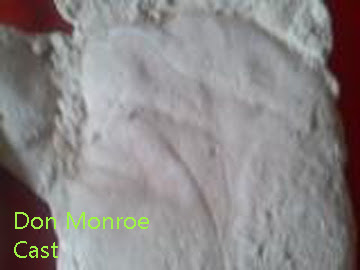Upon occasion, I work with researchers whose time in the field and worldwide range impress the hell out of me. I have been lucky enough to work with Don Monroe on projects and he has shared his 80 years of world exploration and finds. His diligence in long-term studies has been astonishing and he shared with me recently casts he has rendered over the decades from frequently researched locations.

Don describes the majority of the handprints from mud and in caves as having a wide variety of looks, some of them mutations of a sort. He has found prints that he found the identical one miles away and that has given him a range of their habitat. After several decades of researching a 50-mile radius in America's Northwestern States, he has come to learn a few things about these hands.
It is interesting to note the hand creases show the same dexterous use of hands that we possess. I had wondered if they might have a single palmar crease as is found in some genetic variations among us such as those with Down Syndrome. This is referred to as the Simian Crease. This is a complete fusion of the head and heart line on the palm.
Transverse palmar crease
If one needed anymore confirmation that Bigfoot are in the genus of homo, there is no better assurance than to see the creases in the palm (cast above)
The hands in most cases are a foot long. The fingers measuring 8"! If you were to add a foot in length to an arm length, that might seem like a person had a longer arm than usual. That the Bigfoot have long bodies but fingertips hit a good distance on the thigh, we have to wonder if their hands are large like their feet in comparison to our own proportions.
This cast below is significant to me and tells more about Bigfoot hands than any cast I've seen so far.
Open up your palm nice and tight as if stretching your hand open. Do you see the individual tendons across your palm that stretch up to control each finger? Well, on this cast above you can see the pale (raised) areas where those tendons stretch. What this tells me is that they not only utilize the their hands the same (the creases on the palm), but the tendons that regulate the fingers are used to doing some serious pulley work.
Their hands were built to be able to paddle, to hold a very heavy object, to break things open with their bare hands. The strength of their hands would exceed ours many fold.
One thing we haven't discussed is the use of the hands in relation to mobility. There is one odd feature about Bigfoot that seems to defy most people's logic, but makes perfect sense for a high altitude acclimated man, the ability to scramble on all four.
This video (below) was cleaned up by expert MK Davis from a private habituation site/research project from the early 2000s. Look to the left of the dark cow near the top of the frame. At 2:40 mark, a white figure comes out, drops to all four and takes off, then once clearing the tree, stands up to run.
With body proportions that show the legs being one third of the height and arms longer in proportion to ours, getting on all four for a Bigfoot is easy, as their back stays level and their head is hiked up to see around. For us, it is awkward...
If you shift proportions, it becomes a viable way to move about.
Bigfoot's ability to get on all four and gallop across an open area to stay low and out of sight is a valid one as one who is likely adapted for mountainous regions. This would be the ideal mode to get up hillsides, over rock faces, and scramble about and on open plains. This could be a real advantage to almost leap from one area to the next. With larger hands and feet, as well, they have natural land paddles. The tendons on the palms might show just how powerful the hands are to launch off and land.
There is a great deal more to be understood about the adaptations of these people and how they came to be so similar and yet having some design details that make them far superior in strength and stealth. This is a subject I plan to continue to pursue.
Coming soon, the giant handprint in Lovelock Cave and the hand of unknown origin....

























